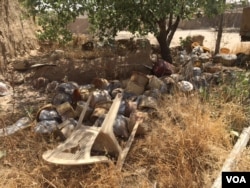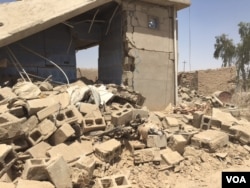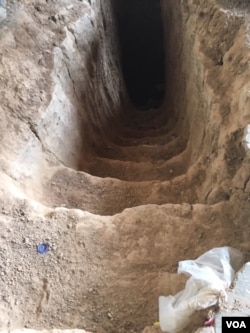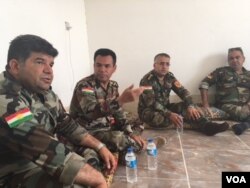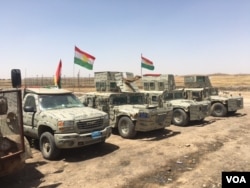The commander leaned over to the driver of the armored car, warning him not to hit the edge of the road, which Islamic State militants had laced with homemade bombs.
Iraqi Kurdish fighters known as the Peshmerga had just cleared this area, pushing their front line against IS 23 kilometers (14 miles) toward the extremist stronghold of Mosul.
But the extremists left behind a deadly trail of bombs, piles of explosives loaded in plastic jugs, and elaborate networks of tunnels.
Bouncing over gravel and dust, the car veered over the road and into newly cut paths through the rubble of what used to be farmland ribboned by small rivers.
Peshmerga bomb disposal units were combing the area, and red flags marked the bombs already found. Dawn brought the sound of bombs being detonated as the cleaning continued.
Two weeks earlier, Peshmerga forces launched an offensive to retake nine villages and the surrounding land east of Mosul.
General Saeed Hazhar led the operation.
"The first front circled behind the enemy with a strong force, and captured the area behind them. In some areas, the enemy fought us, in others, they fled," he told VOA as he walked through the village's streets.
A combination of coalition airstrikes, ground mortar fire and IS suicide bombers crushed the villages, reducing many of the houses to rubble.
"The second front attacked the enemy directly, diverting them from the offensive to the rear. They didn't know what to do," Hazhar said.
Some IS militants hid in the elaborate tunnels they had dug under the villages, and even under nearby hillocks.
The tunnels allowed the militants to travel undetected from house to house, and even to escape the airstrikes. One tunnel was equipped with electricity, a freezer, and makeshift bedrooms with blankets and Qurans.
Many IS militants were killed, he added. The general would not speak about how many Peshmerga were wounded or killed in the assault. Civilians fled the area when IS first arrived two years ago.
Hazhar's fellow commander, General Salar Taimur, explained the IS tactics.
"IS are divided into small teams, spread out in different areas. Some of the teams build tunnels to hide from the airstrikes," Taimur said. They also have a suicide bomber division that they use to carry out suicide attacks.
Gathering in one of the houses abandoned by IS fighters, the Peshmerga commanders sat on the floor, drank tea, smoked cigarettes and talked about the IS command structure.
According to the commanders, every district is controlled by an IS commander. Under him, small teams of four to five militants are delegated to different neighborhoods, and each team has a suicide component.
The suicide bomber, usually driving a vehicle filled with explosives, will try to breach the front line. After that, a wave of IS fighters flood in.
"We know this because we can listen to their conversations on the radios," said one commander, Khader Sheikhani. Most of the conversations are in Arabic, he said.
"IS is well-organized," Sheikhani added, "but we know their strategy now."
He said IS militants typically will start shooting at the Peshmerga to divert their attention from the suicide bomber. IS also has strong sniper teams.
"These are experienced fighters," Sheikhani said.
Taimur said that while mostly older IS militants were in charge of defending the villages, subsequent IS counterattacks were mostly carried out by boys between the ages of 14 to 17.
Working with the Peshmerga here are French, Canadian and British advisers, some with the defensive units and others with the offensive Peshmerga units. A group of French advisers who came to the villages refused to be photographed or interviewed.
Taking the village has brought the Peshmerga to just 20 kilometers east of Mosul. But while the commanders said they are capable of taking Mosul, too, they added that the conditions would have to be right.
An Iraqi army offensive just south of the Peshmerga line halted soon after it started in March.
According to the commanders, the operation stalled after a fight broke out between Sunni tribal fighters and Hashd al Shaabi Shi'ite militias who are supposed to be working in tandem with the Iraqi army.
The Peshmerga commanders warned that the sectarian divisions that plague Iraq could derail the fight against IS extremists in Mosul.
"The Hashd is not as dangerous as IS, but it is dangerous for the Iraqi Sunnis," said one commander.
Outside of some sections of Mosul that are largely Kurdish, the city has a majority Sunni population.
This week, 5,000 additional Iraqi troops started to arrive in Makhmour to reinforce the roughly 5,000 forces already there.
But the Kurdish commanders agree it will take more than numbers to defeat the IS extremists.
"If there is discrimination against ethnic minorities, no, people will prefer to stay under IS, because they know if Shi'ite militia get into the city, there will be a massacre," the commander said.
